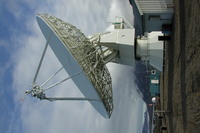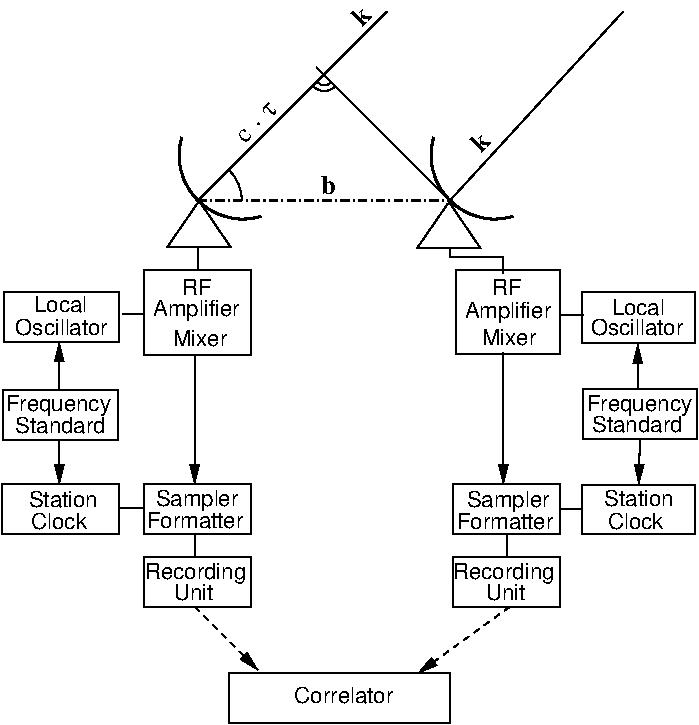 The defining feature of VLBI is that pairs radio telescopes operate together
with observations having to be carried out strictly simultaneously. This also
applies if multiple telescopes are employed. Geodetic VLBI aims at determining
(a) telescope coordinates and their kinematic movements for establishing and
maintaining terrestrial reference frames, (b) the (angular) parameters of the
Earth’s variable rotation, (c) the angular positions of galactic and extra-galactic
radio sources establishing and maintaining celestial reference frames, and (d)
the positions of artificial transmitters in space near the Earth. The field related
to (c) is called astrometry. Besides geodesy and astrometry, VLBI is also a major
contributor to the field of radio astronomy; in fact the origin of the early VLBI
inventions lies in astronomical applications.
The defining feature of VLBI is that pairs radio telescopes operate together
with observations having to be carried out strictly simultaneously. This also
applies if multiple telescopes are employed. Geodetic VLBI aims at determining
(a) telescope coordinates and their kinematic movements for establishing and
maintaining terrestrial reference frames, (b) the (angular) parameters of the
Earth’s variable rotation, (c) the angular positions of galactic and extra-galactic
radio sources establishing and maintaining celestial reference frames, and (d)
the positions of artificial transmitters in space near the Earth. The field related
to (c) is called astrometry. Besides geodesy and astrometry, VLBI is also a major
contributor to the field of radio astronomy; in fact the origin of the early VLBI
inventions lies in astronomical applications.
Geodetic and astrometric VLBI makes use of the fact that every two tele- scopes observing the same object should receive the same radiation pattern because it originates from a single source. Similar to Michelson’s interferom- etry experiment, the two patterns show interferometry patterns, called fringes (oscillations of dark and bright), when the signals are superimposed while the Earth rotates. Of course, this can only be done when the analog signals are digitized and stored on some recording medium and subsequently transported to a central location either on magnetic disks or over the Internet. There, in a process called correlation, the radiation patterns are shifted relative to each other in time to find a correlation maximum which indicates that identity is found. This alone would be futile. However, when recorded in the control rooms of the two radio telescopes, the radiation patterns are marked with ac- curate local time stamps. For the correlation maximum, the difference of these time stamps yields the difference in arrival times of the radiation pattern at the two telescopes which is the time delay, the primary observable of geodetic and astrometric VLBI. Due to the Earth’s rotation and the constantly changing geometry of the radio source and the two telescopes, the delay is constantly changing and, thus, needs an accurate time reference.
 Carrying out a series of up to one-minute-long simultaneous observations
of 50 - 100 radio sources by a network of several telescopes in the course of
several hours (mostly 1 h or 24 h) provides the framework of a single VLBI
measurement often called an observing session. Within these sessions, the pro-
cess, when multiple telescopes track the same source, is called a scan, while
every two telescopes forming a baseline produce a single observation. Since
the radio telescopes, which often are several thousand kilometers apart, oper-
ate independently and sometimes even automatically, a detailed plan of the ob-
servation sequence, the observing schedule, has to be devised and distributed
beforehand. Great care is exerted in preparing these schedules because the
variations in the observation geometry through observing different regions of
the sky are optimized for the best results.
Carrying out a series of up to one-minute-long simultaneous observations
of 50 - 100 radio sources by a network of several telescopes in the course of
several hours (mostly 1 h or 24 h) provides the framework of a single VLBI
measurement often called an observing session. Within these sessions, the pro-
cess, when multiple telescopes track the same source, is called a scan, while
every two telescopes forming a baseline produce a single observation. Since
the radio telescopes, which often are several thousand kilometers apart, oper-
ate independently and sometimes even automatically, a detailed plan of the ob-
servation sequence, the observing schedule, has to be devised and distributed
beforehand. Great care is exerted in preparing these schedules because the
variations in the observation geometry through observing different regions of
the sky are optimized for the best results.
ˍ After correlation and a process called fringe fitting where the final delay ob- servations are determined, geodetic data analysis with adjustment programs is carried out. Here, the geodetic and astrometric parameters of interest (tele- scope coordinates, Earth orientation parameters, and radio source positions) are computed from a large number of observations. For this purpose, all known geophysical effects acting on the telescopes and on the radiation on their way to Earth are modelled as accurately as possible. The functional model of geode- tic and astrometric VLBI makes use of the fact that extra-galactic radio sources are almost infinitely far away so that their radiation arrives on Earth as a plane wave front. This facilitates many necessary computations and assumptions. Obtaining radio telescope coordinates at the current accuracy level of within a few millimeters has been made possible only by ongoing, decades-long re- search toward improvements of VLBI technology.